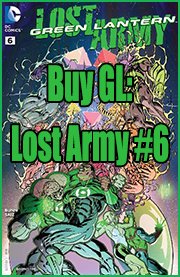John Stewart and the Darkstars
on August 25, 2016

Many fans know that John Stewart was a Darkstar back in the mid-’90s, but not that many actually read the comics that feature him as one. Conceptually, this should be an important part of the character’s history, but the reality is it’s pretty much forgotten and never referenced these days. There are many things from pre-Geoff Johns Green Lantern that aren’t brought up at all anymore, like Kari Limbo, Guy Gardner’s yellow ring, Hal Jordan’s arguably questionable relationship with Arisia, Tom Kalmaku, Ferris Aircraft (somewhat), Rose Hardin, the Mosaic World, John Stewart’s deceased wife Katma Tui (somewhat), and on and on. And yet, John’s time as a Darkstar is even more obscure than all of that. This is ultimately because The Darkstars comic series wasn’t all that popular in its day.
Considering that this should be an important segment of John Stewart’s history, and that not many people actually read these comics, I thought it was worth shining a light on this period from over twenty years ago.
I was fortunate enough to find the entire series in mint condition in a big bundle on eBay. I waited with curiosity for the package to arrive. Like the fans I mentioned above, I always knew John was the leader of the Darkstars, but I did not know the ins-and-outs of it all, and basically no one I knew in person or online really knew, either. Or at least they didn’t talk about it if they did. I always knew John was romantically involved with a blue alien woman named Merayn Dethalis. John was actually with her in the very first Green Lantern comic I ever purchased back in 2003. But I never really knew who she was. Yes, I eventually learned she was a Darkstar, but I only knew what bare bones wiki entries would tell me. Despite being a hardcore John Stewart fan, there was a large, gaping hole in my knowledge of his history. I had to break through the hazy mist and find out for myself what John’s time as a Darkstar was like, and the only way to do that was to read the comics, especially since information about this series was so sparse.
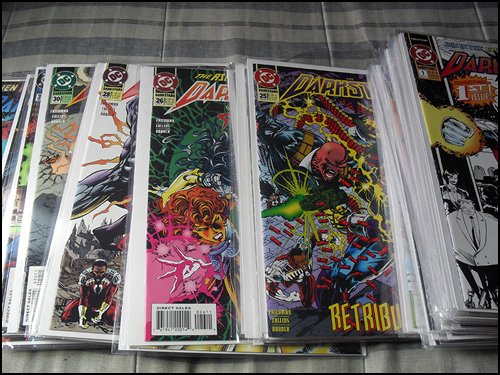
The comics eventually arrived, and read them I did! Before going into the John Stewart specifics, I would like to talk about the series in general.
The Darkstars are a cosmic peace keeping force in the service of The Controllers, Oans who disagreed with the Guardians of the Universe about how best to establish and maintain cosmic order. Because of this, the Controllers left Oa and took up residence in another dimension. The Controllers have sometimes been presented as villainous or vaguely villainous, but not so in this series. The Darkstars are very similar to Green Lanterns in purpose, but instead of using power rings, they use suits that grant them flight, force blasting, heightened defense, and protection from harsh environments, like space. Writer and creator Michael Jan Friedman wanted a tougher, grittier, darker version of Green Lanterns, hence the name Darkstar.
Initially, Friedman set out to mix smaller stories with big cosmic epics. For example, the first arc features an alien crime syndicate spreading an extra-terrestrial drug on the streets of Dallas. It’s an interesting premise, but unfortunately, the execution left quite a bit to be desired.
For probably about half or more of the entire series the book had difficulty getting a regular artist. There were a lot of fill-in rush jobs that I think really harmed the series out the gate and I don’t believe it ever recovered. The book was often rather unsightly, and it has not aged gracefully. The earliest issues are filled with wannabe Jim Lee and Rob Liefeld art that I don’t care for. The book eventually did get a regular artist in Mike Collins, who did an okay job. He was generally competent but lacked a notable or especially attractive style.
The main characters are somewhat interesting. The initial lead character, Ferrin Colos, is like a “bad ass” Abin Sur. The series debuted in the early ‘90s, so it’s no surprise that Colos is full of angst and a bunch of cheesy made up alien curse words, a’la Lobo. His Earth born deputies are more interesting than him. My favorite is a toss-up between Mo Douglas, a homeless man who is generally a cool guy, and Carla White, a young African American woman who is a lawyer. Carla would easily be my favorite, except she spends quite a lot of time pining for Colos, and I just didn’t find the way it was portrayed believable or engaging. Fortunately, her feelings aren’t unrequited, and Ferrin Colos and Carla White officially get together in the final issue. There is also John Flint, a feisty cop who spends most of the series transformed into a hideous, violent monster.
The most interesting villain is the leader of the Darkstars, Jeddigar. As an example of one of the larger cosmic stories, Jeddigar found a baby universe and was planning to expand it and use it to overwrite the regular universe. Naturally, the idea was that he’d be some kind of god in the new universe. John was put in charge of the Darkstars when The Controllers learned of Jeddigar’s plot and summoned John to stop it, which he did. As a reward, John was made Darkstar director.
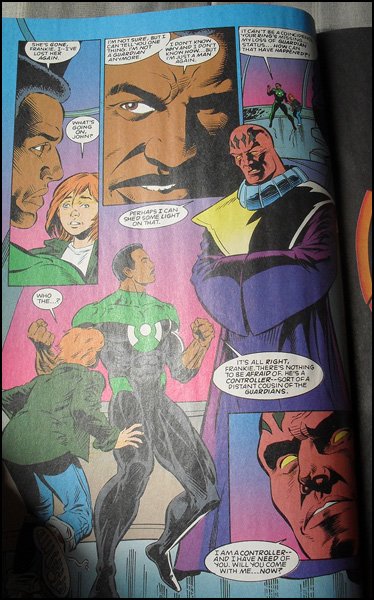
Prior to John’s arrival the book was having problems with sales. The inclusion of John Stewart was part of an initiative to attract readers. Bringing in John was a good idea. His Green Lantern: Mosaic series had recently been cancelled, and with him being a Green Lantern, he was a natural fit. During this period, Hal Jordan went mad, became the super villain Parallax, and decimated the Green Lantern Corps. DC mandated that there could only be one Green Lantern, the newly created Kyle Rayner. The Darkstars series gave John something familiar to do, and he brought many former members of the Green Lantern Corps with him, like Hollicka, Galius, K’ryssma, and Medphyll.
Now, the weird part. Despite getting regular point-of-view scenes, John was a glorified supporting character. Ferrin Colos kept a prominent position in the narrative, but he now had to share much of it with Donna Troy… who is probably one of the strangest characters in DC history, with how she bounces from strange status quo to strange status quo, and different origins, and her involvement in this series is a perfect example of that.
Donna Troy, initially a Wonder Woman character, had absolutely nothing to do with anything even vaguely related to the Darkstars, but DC more or less made her the new main character of the book. I guess the Wonder Woman office had nothing for her at the time, and The Darkstars editor saw it as an opportunity to get Titans fans interested in the waning title. While John brought the ex-Green Lanterns with him, Donna brought a bunch of Titans stuff and her own strange personal baggage involving her ex-husband Terry Long. Donna’s personality isn’t bad, but she and the aspects associated with her are very bizarre additions to the book, especially when she gets most of the focus. It’s just weird that just because Donna is around, the Darkstars come into conflict with Psimon, a Teen Titans villain.
Another character who becomes more important is John’s love interest, Merayn Dethalis, who had been romantically involved with Ferrin Colos in the past. Merayn of the planet Bavacqua Seven is the Darkstar who first discovered Jeddigar’s skulduggery. She was instrumental in his downfall. For John, it was love at first sight. Friedman handles romance rather lazily. Characters are just instantly in love with no real believable build up. While John and Merayn don’t instantly get together as an item, after John meets her about 70% of his monologues are about how attracted he is to her. I know instant attractions happen all the time in real life, but Friedman goes too far with the pining and infatuations.
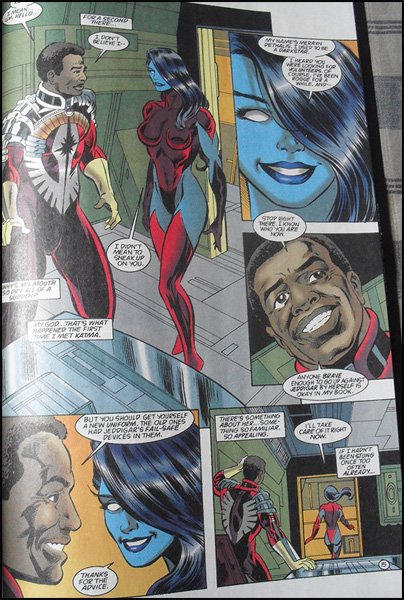
I appreciate Friedman addressing Rose Hardin, John’s previous love interest from Gerard Jones’ Green Lantern: Mosaic, but at the same time, he throws Rose under the bus to get Merayn over. John thinks about how Rose can’t compare to Merayn. Granted, Gerard Jones somewhat threw Rose under the bus himself during the end of Mosaic, but I’m a considerably bigger fan of John’s relationship with Rose and the Mosaic story in general compared to The Darkstars and Merayn, so I see what Friedman did as somewhat tacky and cheap, especially since Friedman doesn’t spend an iota of effort on John/Merayn as Gerard Jones did on John/Rose, which Jones literally built over the course of years and multiple Lantern titles.
What I believe Friedman was trying to do was give John Stewart what he had before, without really giving him what he had. Once again John’s in a cosmic peace keeping corps with ancient immortal masters. Except he’s not a Green Lantern. Once again he falls in love with an alien female member of that Corps. Except she has blue skin instead of red, and she’s not Katma Tui.
There’s a good side and a bad side to this. The good is that given the circumstances—only one Green Lantern (who is not John Stewart) allowed per editorial mandate—this was probably the best thing that DC could have done with John. He still got to be a costumed superhero in a similar setting to what he had before. The bad thing is that, the Darkstars, while interesting, are a poor man’s version of the Green Lantern Corps, and while everything is somewhat familiar, it seems like an imitation rather than something enthralling in its own right. It’s like… instead of eating the real Honey Nut Cheerios… you’re eating that cheap imitation stuff that comes in a bag. There is a difference.
As characters like John, Donna, and Merayn got more focus, the initial characters like Carla, Mo, and John Flint started to recede. Carla gave up being a Darkstar to continue her law practice, John Flint was still a violent monster, but Mo kept on trucking. Regardless of the odd association with the Titans, the book actually did become more interesting with the change of direction. That wasn’t enough to save it from the cancellation axe, however. The Darkstars series ran for forty issues, so anyone looking to dive into it will have a pretty filling read on their hands. Personally, I would have given John a lot more focus and cut Donna completely out of the equation, because she never had any place there to begin with. But what’s done is done… And would that have saved the title? Probably not, but it likely would have been better and made more sense.
John’s time as a Darkstar, while far from perfect, was certainly better than what Ron Marz, the writer of Green Lantern at the time, had in store for him when John was consolidated back into the Green Lantern comic. Marz (and/or Editor Kevin Dooley) clearly didn’t want even an inkling of competition for Kyle Rayner, so he promptly destroyed the Darkstars and physically crippled John Stewart. Both moves were completely needless. Making matters even more hilarious was that some totally other writer in Final Night had John Stewart healed by a remorseful Hal Jordan/Parallax, and Marz promptly crippled John again when he got the opportunity to. The Darkstars gave John and many former GLC members a place in the DCU that wasn’t in anyone’s way. But apparently, DC didn’t want any of those characters at the time. John’s lot became offering Kyle Rayner advice while sitting at home in a wheelchair, drinking coffee, and running an architecture firm with Merayn Dethalis, who was also no longer a Darkstar, but the happy secretary.

I’m truly surprised Merayn lasted as long as she did. She survived at John Stewart’s side through three different writers (Michael Jan Friedman, Ron Marz, and Judd Winnick), two different comic book titles, and about eight years. It’s actually a stunning feat that no other love interest of John’s can claim. At the same time, Merayn is probably John’s most obscure love interest. I believe the reason Merayn was around for so long is because no one at DC really had anything for John to do, so they just kept him with her. When writers actually have an idea for John, they often give him their own love interest. Len Wein used Tawny Young. Steve Englehart used Katma Tui, Gerard Jones used Rose Hardin, Michael Jan Friedman used Merayn Dethalis, and Bruce Timm used Hawkgirl.
So, why did the Darkstars as a concept and comic series ultimately fail and fade into obscurity?
First, their uniforms are extremely gaudy. Comics are a visual medium, and unsightly costumes are damaging to the heroes that wear them. Furthermore, their powers are uninspired. Darkstars fly, shoot beams from their hands, and have heightened defense. That’s basically it. Readers will naturally compare the Darkstars to Green Lanterns (even the writer did this in the letters column), and with less interesting powers, a worse look, and way less name recognition, one begins to wonder why they should care about this concept. It’s my view that if you’re going to shamelessly ape something, then it should at least be better than the original. Otherwise, why bother, and why should anyone bother with you?
Then there is the issue with the irregular artists, many of whom were poor. And at the core of it, the characters, stories, and writing in general just weren’t captivating. They weren’t offensively bad, but they weren’t good, either. I believe the Darkstars, and especially the Controllers are concepts worth revisiting, because with some spit, polish, and updating, I think they can be made to work in some capacity, and I even feature them in my own comic series, Green Lantern: Starlit Crisis. That said, I can see why no one (besides me) has really bothered to do much with them since Ron Marz wiped them out, because there really isn’t much of a reason to care.
Would I like to see John Stewart as a Darkstar again? Only in flashbacks, but I would like to see his history with the Darkstars and Controllers referenced. Having read every key John Stewart appearance, he actually has an interesting history if writers cared to research and exploit it, and are clever enough to do so in a good way, and the Darkstars are a part of that history. Instead, it seems that most writers only see John’s failure in Cosmic Odyssey, which is unfortunate.
Is The Darkstars series worth hunting down and reading? I can’t say that it is, unless you’re like me and hunt down all John Stewart appearances you deem important enough. In this series you will see how John became leader of the Darkstars, and romantically involved with Merayn, which are both important parts of his history, in my opinion, but most of that happens in the twilight of the series. It probably isn’t worth you reading the whole thing just to see those instances, because the comics aren’t especially great, or even good. They are mediocre at best.
I do hope this exploration of an obscure period in John’s history was useful to some.

GreenLantern.Co has launched its own mailing list! This will help readers keep up with all the updates going on around here, and there will be bonuses for subscribers, like an early look at Green Lantern: Starlit Crisis pages and exclusive content. To sign up for regular updates, click the button below and enter your e-mail address.
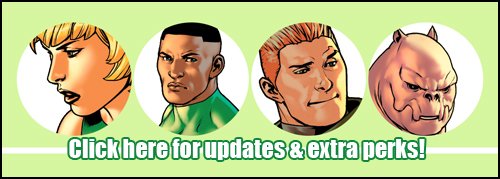
Also, don’t forget to support .Co on Patreon and follow on Twitter. See you soon!

Follow @deshderringer
-
PadThai2
-
Desh Derringer
-
-
Blakk Jakk














